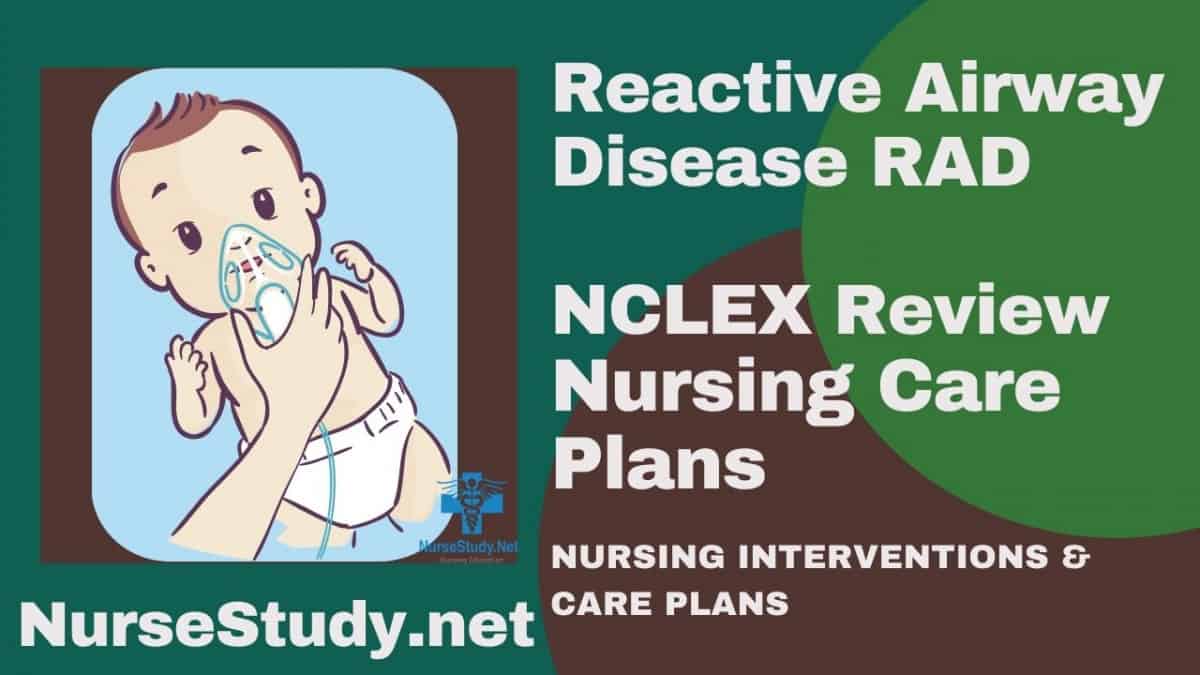Reactive Airway Disease (RAD) is a respiratory condition characterized by bronchial hyperresponsiveness and reversible airway obstruction. Reactive Airway Disease nursing diagnosis focuses on identifying and managing symptoms, preventing exacerbations, and improving patient outcomes.
Causes (Related to)
Various factors can trigger Reactive Airway Disease:
- Exposure to environmental irritants
- Smoke
- Strong odors
- Air pollution
- Cold air
- Medical conditions
- Respiratory infections
- Allergies
- Asthma
- GERD
- Physical factors
- Exercise
- Stress
- Weather changes
Signs and Symptoms (As evidenced by)
Subjective: (Patient reports)
- Wheezing
- Shortness of breath
- Chest tightness
- Chronic cough
- Difficulty performing daily activities
- Sleep disturbances
- Anxiety about breathing difficulties
Objective: (Nurse assesses)
- Audible wheezing
- Use of accessory muscles
- Decreased oxygen saturation
- Tachypnea
- Prolonged expiratory phase
- Decreased peak flow readings
- Abnormal breath sounds
- Cyanosis in severe cases
Expected Outcomes
- The patient will maintain oxygen saturation >95%
- The patient will demonstrate effective breathing techniques
- The patient will identify and avoid triggers
- The patient will correctly use the prescribed medications
- The patient will report a decreased frequency of symptoms
- The patient will perform ADLs without respiratory distress
- The patient will demonstrate proper use of inhalers/nebulizers
Nursing Assessment
Respiratory Assessment
- Monitor breathing patterns and rate
- Assess breath sounds
- Evaluate the use of accessory muscles
- Check oxygen saturation
- Measure peak flow readings
Trigger Identification
- Document environmental factors
- Review recent exposures
- Assess seasonal patterns
- Evaluate the home/work environment
Medication Compliance
- Review current medications
- Assess inhaler technique
- Monitor medication effectiveness
- Document side effects
Activity Tolerance
- Evaluate exercise capacity
- Assess ADL performance
- Monitor fatigue levels
- Document activity limitations
Psychosocial Status
- Assess anxiety levels
- Evaluate coping mechanisms
- Document support system
- Monitor sleep patterns
Nursing Care Plans
Nursing Care Plan 1: Ineffective Breathing Pattern
Nursing Diagnosis Statement:
Ineffective Breathing Pattern related to bronchial hyperresponsiveness as evidenced by wheezing, dyspnea, and use of accessory muscles.
Related Factors:
- Airway inflammation
- Bronchospasm
- Increased mucus production
- Anxiety
Nursing Interventions and Rationales:
- Position patient in semi-Fowler’s position
Rationale: Promotes optimal lung expansion - Teach pursed-lip breathing
Rationale: Reduces air trapping and improves ventilation - Monitor oxygen saturation
Rationale: Ensures adequate oxygenation
Desired Outcomes:
- The patient will maintain oxygen saturation >95%
- The patient will demonstrate effective breathing techniques
- The patient will report decreased work of breathing
Nursing Care Plan 2: Activity Intolerance
Nursing Diagnosis Statement:
Activity Intolerance related to impaired gas exchange as evidenced by dyspnea with exertion and fatigue.
Related Factors:
- Respiratory compromise
- Decreased energy
- Fear of dyspnea
- Deconditioning
Nursing Interventions and Rationales:
- Plan activities with rest periods
Rationale: Prevents overexertion - Implement energy conservation techniques
Rationale: Maximizes available energy - Monitor vital signs during activity
Rationale: Ensures safe activity progression
Desired Outcomes:
- The patient will participate in daily activities without severe dyspnea
- The patient will demonstrate improved exercise tolerance
- The patient will utilize energy conservation techniques
Nursing Care Plan 3: Anxiety
Nursing Diagnosis Statement:
Anxiety related to difficulty breathing, as evidenced by expressed concerns and increased respiratory rate.
Related Factors:
- Fear of suffocation
- Past experiences with dyspnea
- Limited coping mechanisms
- Social isolation
Nursing Interventions and Rationales:
- Teach relaxation techniques
Rationale: Reduces anxiety and breathing difficulty - Provide emotional support
Rationale: Builds confidence in managing symptoms - Educate about medication use
Rationale: Increases sense of control
Desired Outcomes:
- The patient will demonstrate reduced anxiety levels
- The patient will use effective coping strategies
- Patient will verbalize understanding of disease management
Nursing Care Plan 4: Ineffective Airway Clearance
Nursing Diagnosis Statement:
Ineffective Airway Clearance related to increased mucus production as evidenced by ineffective cough and adventitious breath sounds.
Related Factors:
- Bronchial inflammation
- Thick secretions
- Fatigue
- Ineffective coughing
Nursing Interventions and Rationales:
- Teach effective coughing techniques
Rationale: Promotes secretion clearance - Encourage adequate hydration
Rationale: Thins secretions - Perform chest physiotherapy as ordered
Rationale: Mobilizes secretions
Desired Outcomes:
- The patient will demonstrate effective coughing
- The patient will maintain clear breath sounds
- The patient will expectorate secretions effectively
Nursing Care Plan 5: Knowledge Deficit
Nursing Diagnosis Statement:
Knowledge Deficit related to lack of information about RAD management as evidenced by incorrect inhaler technique and poor trigger avoidance.
Related Factors:
- Limited previous exposure to information
- Misunderstanding of management strategies
- Complex medication regimen
- Language barriers
Nursing Interventions and Rationales:
- Provide disease education
Rationale: Improves self-management skills - Demonstrate proper inhaler technique
Rationale: Ensures medication effectiveness - Review trigger avoidance strategies
Rationale: Prevents exacerbations
Desired Outcomes:
- The patient will demonstrate the correct inhaler technique.
- The patient will identify common triggers
- The patient will verbalize understanding of management plan
References
- García-Marcos Alvarez L, Götz M. Asma y enfermedades crónicas de la vía respiratoria superior [Asthma and chronic diseases of the upper respiratory airway]. An Esp Pediatr. 2001 Jun;54(6):567-72. Spanish. PMID: 11412404.
- Huang JL, Lin TY, Wang KF. Sinusitis and bronchial asthma in children. Zhonghua Min Guo Xiao Er Ke Yi Xue Hui Za Zhi. 1995 Jan-Feb;36(1):20-3. PMID: 7778440.
- Oliveira CA, Solé D, Naspitz CK, Rachelefsky GS. Improvement of bronchial hyperresponsiveness in asthmatic children treated for concomitant sinusitis. Ann Allergy Asthma Immunol. 1997 Jul;79(1):70-4. doi: 10.1016/S1081-1206(10)63088-8. PMID: 9236504.
- Rachelefsky GS, Katz RM, Siegel SC. Chronic sinus disease with associated reactive airway disease in children. Pediatrics. 1984 Apr;73(4):526-9. PMID: 6709434.
